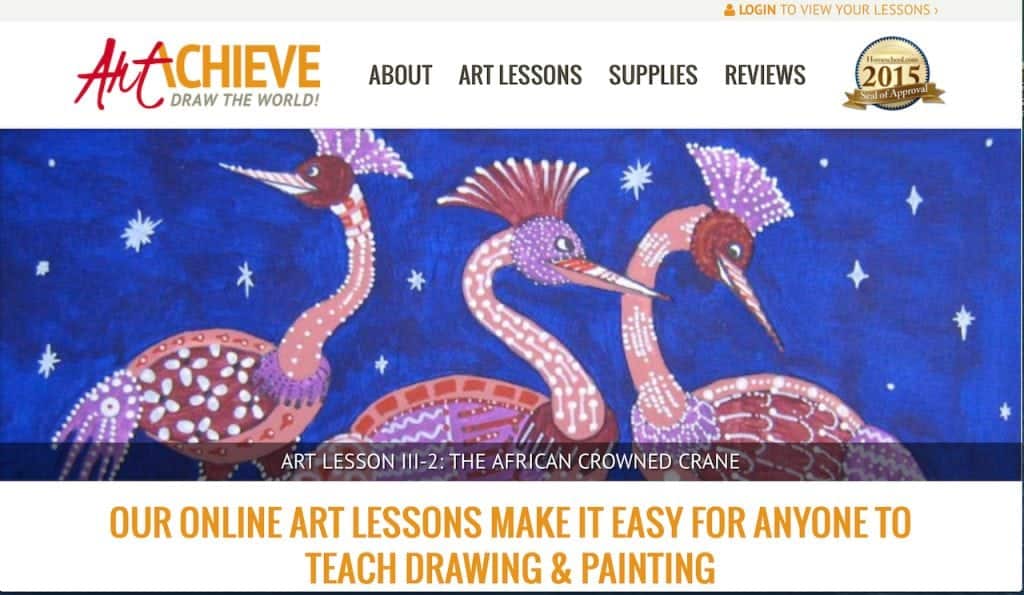Make Friends with Your Inner Art Teacher
You know those nagging thoughts that get in the way of teaching art?
I have no artistic talent. The only thing I can draw is a stick figure.
I have no art background. How could I evaluate my children’s work?
I have no time. Other subjects take too much time.
My kids are not creative. They don’t like art.
Did you know that those nagging thoughts are reasons that could actually HELP you teach art?
The lack of talent.
Looking for resources on how to teach art in your homeschool, art project ideas or homeschool art curriculum? You’ll find additional articles on how to homeschool art.
If the only thing you can draw is a stick figure, regard yourself as highly talented!
You are able to draw an oval (the head),
You know how to draw dots (the eyes),
You can draw straight lines (the body and arms),
You know how to draw curved lines (the mouth),
And wavy lines (the hair),
And you know how to draw an angle (the legs)!
Think about it: are there any other kinds of lines? It’s true there are different kinds of ovals, and wavy lines come in all kinds of shapes, but there just aren’t any other kinds of lines than these six! With these six lines, you can draw anything! So admit it: You have all the tools you need to get started drawing really wonderful, complicated objects!
Drawing: Talent or Skill?
“BUT,” continues the nagging thought, “just because I can draw six easy lines doesn’t mean I could use them to draw “real” stuff. My drawings are awful. I wouldn’t show them to my cat! I have no talent for art.”
Imagine if we approached other things that way.
You probably know how to ride a bicycle. Imagine how well you could ride today if, when someone offered to teach you to ride a bike, you had said, “I have no talent for riding bikes.”
You probably know how to read. Imagine if, on the first day of school, you had told your teacher, “Reading? I have no talent.”
Like learning to read, learning to draw means learning a skill.
You learned to read because you had instruction. You learned to ride a bike because someone taught you and installed training wheels on your bike. If you cannot draw, it’s not because you lack talent—you’ve already mastered the six lines! But you MIGHT be lacking instruction. Find some good, affordable art lessons and learn this valuable skill!
The Lack of Background
Teachers need to be evaluators, but how do you evaluate art?
What kind of feedback can you provide if you lack an art background? It’s easy. Just remember these four C’s:
Craftsmanship—Did students put in the necessary effort to make it look good?
Composition—Did students use the whole page? Are things arranged in a pleasing way?
Comprehension—Did students show they understand the art concepts used in the lesson?
Creativity—Did students go beyond the directions and apply their own unique observation or twist on the subject?
With these four tools you’ll be on your way to providing valuable feedback!
The Lack of Time
In order to learn any concept, we need to make a mental image of it. No mental image, no concept. That’s why historical stories are so important to history lessons—they give us images. It’s why models are important to science lessons. It’s also why art lessons need to be connected to other subjects. They provide the necessary visual images that make the subject memorable.
Don’t worry that you lack the time to teach art. Worry instead about how your other subjects will suffer it you DON’T connect them to art!
Kids Who Are Not Creative
Let’s be honest: to be human is to be creative, and we remain that way unless our creativity has been stifled. If your child doesn’t like art, learn what is getting in the way.
Is it—
Because disappointment in their own work made them give up? Provide art lessons that ensure success. Another way to provide support is to do a lesson along side them. They’ll see that your work isn’t “perfect” either.
Because they don’t like to sit still so long? A good art lesson will have several parts. Stop when you get to the end of one part, and pick up where you left off the next day.
Finally
We all have those nagging thoughts about teaching art. But next time the thoughts come knocking at your homeschool door, remember that it’s all a matter of how you think about things. You’ve been created with artistic, creative talent—you can develop it or stifle it. As you develop your God-given talent, you’ll learn to look at things more carefully. That’s the first step to learning curiosity. And curiosity is the first step to learning. ART and ACADEMICS go hand-in-hand!
Do you need other resources to help you teach art in your homeschool, art project ideas or even suggestions for homeschool art curriculum? Check out these other articles on how to homeschool art.

Disclosure: This post is sponsored by John of ArtAchieve.








Thanks so much. I am not an artist by any stretch, but I LOVE teaching my kids art because they love it. It’s especially cool when we can tie it to another subject like literature. This year we are also getting my son professional lessons to expand on what I can teach him at home.